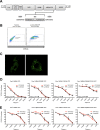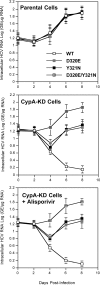Multiple mutations in hepatitis C virus NS5A domain II are required to confer a significant level of resistance to alisporivir
- PMID: 22802259
- PMCID: PMC3457393
- DOI: 10.1128/AAC.00919-12
Multiple mutations in hepatitis C virus NS5A domain II are required to confer a significant level of resistance to alisporivir
Abstract
Alisporivir is the most advanced host-targeting antiviral cyclophilin (Cyp) inhibitor in phase III studies and has demonstrated a great deal of promise in decreasing hepatitis C virus (HCV) viremia in infected patients. In an attempt to further elucidate the mechanism of action of alisporivir, HCV replicons resistant to the drug were selected. Interestingly, mutations constantly arose in domain II of NS5A. To demonstrate that these mutations are responsible for drug resistance, they were reintroduced into the parental HCV genome, and the resulting mutant viruses were tested for replication in the presence of alisporivir or in the absence of the alisporivir target, CypA. We also examined the effect of the mutations on NS5A binding to itself (oligomerization), CypA, RNA, and NS5B. Importantly, the mutations did not affect any of these interactions. Moreover, the mutations did not preserve NS5A-CypA interactions from alisporivir rupture. NS5A mutations alone render HCV only slightly resistant to alisporivir. In sharp contrast, when multiple NS5A mutations are combined, significant resistance was observed. The introduction of multiple mutations in NS5A significantly restored viral replication in CypA knockdown cells. Interestingly, the combination of NS5A mutations renders HCV resistant to all classes of Cyp inhibitors. This study suggests that a combination of multiple mutations in domain II of NS5A rather than a single mutation is required to render HCV significantly and universally resistant to Cyp inhibitors. This in accordance with in vivo data that suggest that alisporivir is associated with a low potential for development of viral resistance.
Figures






Similar articles
-
HCV resistance to cyclosporin A does not correlate with a resistance of the NS5A-cyclophilin A interaction to cyclophilin inhibitors.J Hepatol. 2010 Jul;53(1):50-6. doi: 10.1016/j.jhep.2010.01.041. Epub 2010 Apr 3. J Hepatol. 2010. PMID: 20451281 Free PMC article.
-
DEB025 (Alisporivir) inhibits hepatitis C virus replication by preventing a cyclophilin A induced cis-trans isomerisation in domain II of NS5A.PLoS One. 2010 Oct 27;5(10):e13687. doi: 10.1371/journal.pone.0013687. PLoS One. 2010. PMID: 21060866 Free PMC article.
-
Sensitivity of hepatitis C virus to cyclosporine A depends on nonstructural proteins NS5A and NS5B.Hepatology. 2007 Oct;46(4):1026-33. doi: 10.1002/hep.21809. Hepatology. 2007. PMID: 17600342
-
Profile of alisporivir and its potential in the treatment of hepatitis C.Drug Des Devel Ther. 2013;7:105-15. doi: 10.2147/DDDT.S30946. Epub 2013 Feb 15. Drug Des Devel Ther. 2013. PMID: 23440335 Free PMC article. Review.
-
Hepatitis C NS5A protein: two drug targets within the same protein with different mechanisms of resistance.Curr Opin Virol. 2014 Oct;8:30-7. doi: 10.1016/j.coviro.2014.04.012. Epub 2014 May 27. Curr Opin Virol. 2014. PMID: 24879295 Free PMC article. Review.
Cited by
-
Phenotypic analysis of NS5A variant from liver transplant patient with increased cyclosporine susceptibility.Virology. 2013 Feb 20;436(2):268-73. doi: 10.1016/j.virol.2012.11.018. Epub 2013 Jan 2. Virology. 2013. PMID: 23290631 Free PMC article.
-
The Novel Cyclophilin Inhibitor CPI-431-32 Concurrently Blocks HCV and HIV-1 Infections via a Similar Mechanism of Action.PLoS One. 2015 Aug 11;10(8):e0134707. doi: 10.1371/journal.pone.0134707. eCollection 2015. PLoS One. 2015. PMID: 26263487 Free PMC article.
-
The role of immunophilins in viral infection.Biochim Biophys Acta. 2015 Oct;1850(10):2103-10. doi: 10.1016/j.bbagen.2014.11.011. Epub 2014 Nov 18. Biochim Biophys Acta. 2015. PMID: 25445708 Free PMC article.
-
Cyclophilin Inhibitors Remodel the Endoplasmic Reticulum of HCV-Infected Cells in a Unique Pattern Rendering Cells Impervious to a Reinfection.PLoS One. 2016 Jul 21;11(7):e0159511. doi: 10.1371/journal.pone.0159511. eCollection 2016. PLoS One. 2016. PMID: 27442520 Free PMC article.
-
Exploration of the Role of Cyclophilins in Established Hepatitis B and C Infections.Viruses. 2024 Dec 25;17(1):11. doi: 10.3390/v17010011. Viruses. 2024. PMID: 39861799 Free PMC article.
References
-
- Ahn J, et al. 2004. Systematic identification of hepatocellular proteins interacting with NS5A of the hepatitis C virus. J. Biochem. Mol. Biol. 37:741–748 - PubMed
-
- Armstrong GL, et al. 2006. The prevalence of hepatitis C virus infection in the United States, 1999 through 2002. Ann. Intern. Med. 144:705–714 - PubMed
Publication types
MeSH terms
Substances
Grants and funding
LinkOut - more resources
Full Text Sources

